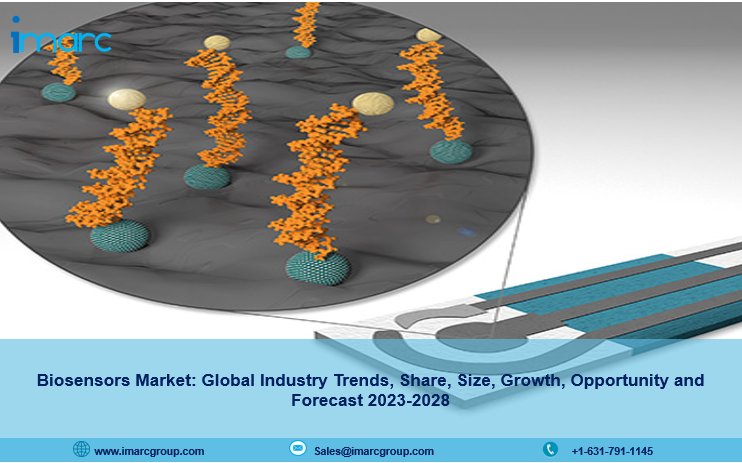Biosensors Market Size, Demand, Industry Growth And Forecast 2023-2028

The latest report by IMARC Group, titled “Biosensors Market: Global Industry Trends, Share, Size, Growth, Opportunity and Forecast 2023-2028“. The global biosensors market size reached US$ 26.5 Billion in 2022. Looking forward, IMARC Group expects the market to reach US$ 43.0 Billion by 2028, exhibiting a growth rate (CAGR) of 8.2% during 2023-2028.
Biosensors, also known as biological sensors, are analytical devices that detect numerous biological substances, including biomolecules and microorganisms. They comprise several components, such as a signal conditioning circuit, mediator, microcontroller, analyte, a reader device, and transducer, which enable the conversion of biological responses into electronic or digital signals. Some commonly known biosensors include electrochemical, nanomechanical, optical, piezoelectric, and thermal sensors.
These sensors can monitor several biological components, including tissues, cell receptors, enzymes, nucleic acids, microorganisms, and antibodies. Additionally, they are utilized for disease monitoring, detection of pollutants, drug discovery, disease-causing microorganisms, forensic research, and markers that are indicators of disease in bodily fluids such as blood, saliva, urine, and sweat. Nowadays, biosensors are widely adopted in point-of-care (POC), research laboratories, home healthcare diagnostics, and security and biodefense applications across the globe.
Request Your Sample Report Now: https://www.imarcgroup.com/biosensors-market/requestsample
Biosensors Market Trends and Drivers:
The market is primarily driven by the growing occurrences of chronic diseases such as diabetes, cardiovascular diseases (CVDs), prostate and breast cancer, hepatitis B virus, and celiac disease. In addition, the escalating demand for compact diagnostic devices, including biosensors, to identify and monitor these medical illnesses is contributing to market growth. In line with this, emerging technological advancements, such as the incorporation of the Internet of Things (IoT)-connected devices and the development of innovative nanotechnology-based biosensors that utilize nanowires, nanorods, nanotubes, and nanoparticles for biomolecular detection represent another major growth-inducing factor.
Besides this, the rising demand for wearable biosensors to monitor the vital signs of athletes, infants, patients, children, and fitness enthusiasts is accelerating the product adoption rate. Along with this, the recent outbreak of the coronavirus (COVID-19) pandemic, resulting in the extensive demand for biosensors in the healthcare sector for continuous monitoring of patients, is propelling the market growth. Apart from this, the biosensors market is growing at different rates in numerous regions, with North America being the largest market due to the introduction of miniaturized diagnostic equipment, several technological advancements, and the presence of numerous key players across the region. Moreover, the industry is expected to face competition in the upcoming years as numerous key players are implementing competitive strategies to sustain their presence in the market. Furthermore, new product launches, extensive research and development (R&D) activities, and mergers and acquisitions (M&A) among leading market players, the increasing demand for point-of-care testing driven by factors such as the need for quick diagnosis and treatment, rising prevalence of chronic diseases, and the need of decentralized testing, are some of the other factors creating a positive market outlook.
Report Segmentation:
The report has segmented the market into the following categories:
Breakup by Product:
- Wearable Biosensors
- Non-Wearable Biosensors
Breakup by Technology:
- Electrochemical Biosensors
- Optical Biosensors
- Piezoelectric Biosensors
- Thermal Biosensors
- Nanomechanical Biosensors
- Others
Breakup by Application:
- Blood Glucose Testing
- Cholesterol Testing
- Blood Gas Analysis
- Pregnancy Testing
- Drug Discovery
- Infectious Disease Testing
- Others
Breakup by End Use:
- Point of Care Testing
- Home Healthcare Diagnostics
- Research Laboratories
- Security and Biodefense
- Others
Market Breakup by Region:
- North America (United States, Canada)
- Asia-Pacific (China, Japan, India, South Korea, Australia, Indonesia, Others)
- Europe (Germany, France, United Kingdom, Italy, Spain, Russia, Others)
- Latin America (Brazil, Mexico, Others)
- Middle East and Africa
Competitive Landscape with Key Player:
- Abbott Laboratories
- AgaMatrix Inc. (WaveForm Technologies Inc)
- DuPont de Nemours Inc.
- Hoffmann-La Roche AG
- General Electric Company
- LifeScan Inc. (Platinum Equity LLC)
- Medtronic PLC
- Nova Biomedical Corporation
- PHC Holdings Corporation
- Siemens AG
- Thermo Fisher Scientific Inc.
Note: If you need specific information that is not currently within the scope of the report, we will provide it to you as a part of the customization.
About Us
IMARC Group is a leading market research company that offers management strategy and market research worldwide. We partner with clients in all sectors and regions to identify their highest-value opportunities, address their most critical challenges, and transform their businesses.
IMARC’s information products include major market, scientific, economic and technological developments for business leaders in pharmaceutical, industrial, and high technology organizations. Market forecasts and industry analysis for biotechnology, advanced materials, pharmaceuticals, food and beverage, travel and tourism, nanotechnology and novel processing methods are at the top of the company’s expertise.
Contact Us
IMARC Group
Email: sales@imarcgroup.com
USA: +1-631-791-1145 | Asia: +91-120-433-0800
Address: 134 N 4th St. Brooklyn, NY 11249, USA
Follow us on Twitter: @imarcglobal
- Industry
- Art
- Causes
- Crafts
- Dance
- Drinks
- Film
- Fitness
- Food
- Games
- Gardening
- Health
- Home
- Literature
- Music
- Networking
- Other
- Party
- Religion
- Shopping
- Sports
- Theater
- Wellness
- News


